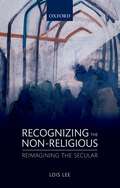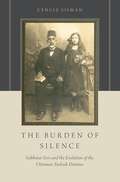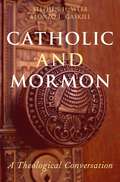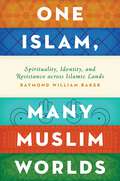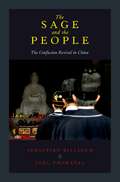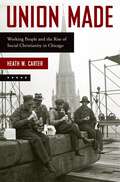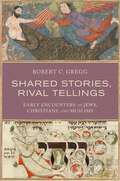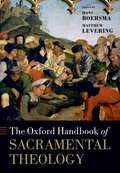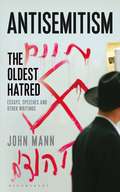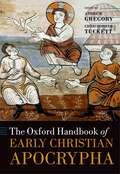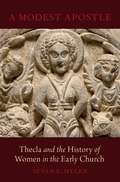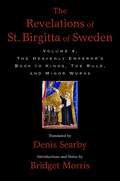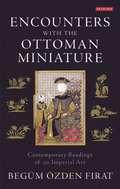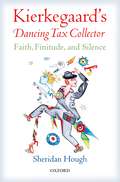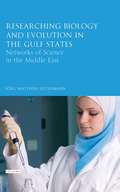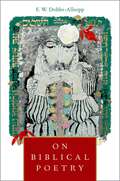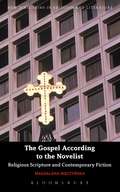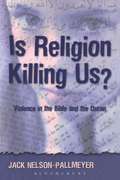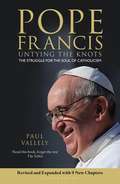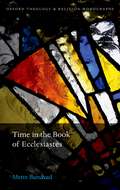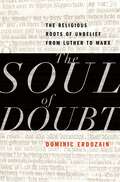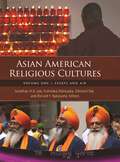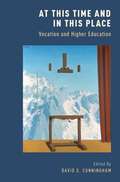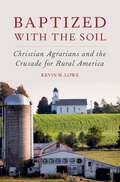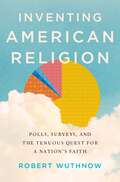- Table View
- List View
Recognizing the Non-religious: Reimagining the Secular
by Lois LeeIn recent years, the extent to which contemporary societies are secular has come under scrutiny. At the same time, many countries, especially in Europe, have increasingly large nonaffiliate, 'subjectively secular' populations, whilst nonreligious cultural movements like the New Atheism and the Sunday Assembly have come to prominence. Making sense of secularity, irreligion, and the relationship between them has therefore emerged as a crucial task for those seeking to understand contemporary societies and the nature of modern life. Drawing on ethnographic fieldwork in southeast England, Recognizing the Non-religious develops a new vocabulary, theory and methodology for thinking about the secular. It distinguishes between separate and incommensurable aspects of so-called secularity as insubstantial—involving merely the absence of religion—and substantial—involving beliefs, ritual practice, and identities that are alternative to religious ones. Recognizing the cultural forms that present themselves as non-religious therefore opens up new, more egalitarian and more theoretically coherent ways of thinking about people who are 'not religious'. It is also argued that recognizing the nonreligious allows us to reimagine the secular itself in new and productive ways. This book is part of a fast-growing area of research that builds upon and contributes to theoretical debates concerning secularization, 'desecularization', religious change, postsecularity and postcolonial approaches to religion and secularism. As well as presenting new research, this book gathers insights from the wider studies of nonreligion, atheism, and secularism in order to consolidate a theoretical framework, conceptual foundation and agenda for future research.
The Burden of Silence: Sabbatai Sevi and the Evolution of the Ottoman-Turkish Dönmes
by Cengiz SismanThe Burden of Silence is the first monograph on Sabbateanism, an early modern Ottoman-Jewish messianic movement, tracing it from its beginnings during the seventeenth century up to the present day. Initiated by the Jewish rabbi Sabbatai Sevi, the movement combined Jewish, Islamic, and Christian religious and social elements and became a transnational phenomenon, spreading througout Afro-Euroasia. When Ottoman authorities forced Sevi to convert to Islam in 1666, his followers formed messianic crypto-Judeo-Islamic sects, Dönmes, which played an important role in the modernization and secularization of Ottoman and Turkish society and, by extension, Middle Eastern society as a whole. Using Ottoman, Jewish, and European sources, Sisman examines the dissemination and evolution of Sabbeateanism in engagement with broader topics such as global histories, messianism, mysticism, conversion, crypto-identities, modernity, nationalism, and memory. By using flexible and multiple identities to stymie external interference, the crypto-Jewish Dönmes were able to survive despite persecution from Ottoman authorities, internalizing the Kabbalistic principle of a "burden of silence" according to which believers keep their secret on pain of spiritual and material punishment, in order to sustain their overtly Muslim and covertly Jewish identities. Although Dönmes have been increasingly abandoning their religious identities and embracing (and enhancing) secularism, individualism, and other modern ideas in the Ottoman Empire and modern Turkey since the nineteenth century, Sisman asserts that, throughout this entire period, religious and cultural Dönmes continued to adopt the "burden of silence" in order to cope with the challenges of messianism, modernity, and memory.
Catholic and Mormon: A Theological Conversation
by Stephen H. Webb Alonzo L. GaskillWhat could Roman Catholicism and Mormonism possibly have to learn from each other? On the surface, they seem to diverge on nearly every point, from their liturgical forms to their understanding of history. With its ancient roots, Catholicism is a continuous tradition, committed to the conservation of the creeds, while Mormonism teaches that the landscape of Christian history is riddled with errors and apostasy and in need of radical revision and spiritual healing. Additionally, successful proselyting efforts by Mormons in formerly Catholic strongholds have increased opportunities for misunderstanding, polemic, and prejudice between the two faiths. However, as demonstrated in this unique and spirited dialogue between two theologians, one a convert to Catholicism and the other a convert to Mormonism, these two traditions are much closer to each other than many assume, including in their treatment of central doctrines such as authority, grace, Jesus, Mary, and revelation. Both Catholicism and Mormonism have ambitiously universal views of the Christian faith, and readers will be surprised by how close Catholics and Mormons are on a number of topics and how these traditions, probed to their depths, shed light on each other in fascinating and unexpected ways. Catholic and Mormon is an invitation to the reader to engage in a discussion that makes understanding the goal, and marks a beginning for a dialogue that will become increasingly important in the years to come.
One Islam, Many Muslim Worlds: Spirituality, Identity, and Resistance across Islamic Lands (Religion and Global Politics)
by Raymond William BakerBy all measures, the late twentieth century was a time of dramatic decline for the Islamic world, the Ummah, particularly its Arab heartland. Sober Muslim voices regularly describe their current state as the worst in the 1,400-year history of Islam. Yet, precisely at this time of unprecedented material vulnerability, Islam has emerged as a civilizational force strong enough to challenge the imposition of Western, particularly American, homogenizing power on Muslim peoples. This is the central paradox of Islam today: at a time of such unprecedented weakness in one sense, how has the Islamic Awakening, a broad and diverse movement of contemporary Islamic renewal, emerged as such a resilient and powerful transnational force and what implications does it have for the West? In One Islam, Many Muslims Worlds Raymond W. Baker addresses this question. Two things are clear, Baker argues: Islam's unexpected strength in recent decades does not originate from official political, economic, or religious institutions, nor can it be explained by focusing exclusively on the often-criminal assertions of violent, marginal groups. While extremists monopolize the international press and the scholarly journals, those who live and work in the Islamic world know that the vast majority of Muslims reject their reckless calls to violence and look elsewhere for guidance. Baker shows that extremists draw their energy and support not from contributions to the reinterpretation and revival of Islamic beliefs and practices, but from the hatreds engendered by misguided Western policies in Islamic lands. His persuasive analysis of the Islamic world identifies centrists as the revitalizing force of Islam, saying that they are responsible for constructing a modern, cohesive Islamic identity that is a force to be reckoned with.
The Sage and the People: The Confucian Revival in China
by Sebastien Billioud Joel ThoravalWinner of the 2015 Pierre-Antoine Bernheim Prize for the History of Religion by the Académie des Inscriptions et Belles-Lettres After a century during which Confucianism was viewed by academics as a relic of the imperial past or, at best, a philosophical resource, its striking comeback in Chinese society today raises a number of questions about the role that this ancient tradition might play in a contemporary context. The Sage and the People is the first comprehensive enquiry into the "Confucian revival" that began in China during the 2000s. Based on extensive anthropological fieldwork carried out over eight years in various parts of the country, it explores the re-appropriation and reinvention of popular practices in fields as diverse as education, self-cultivation, religion, ritual, and politics. The book analyzes the complexity of the "Confucian revival" within the broader context of emerging challenges to such categories as religion, philosophy, and science that prevailed in modernization narratives throughout the last century. Exploring state cults both in Mainland China and Taiwan, authors Sébastien Billioud and Joël Thoraval compare the interplay between politics and religion on the two shores of the Taiwan strait and attempt to shed light on possible future developments of Confucianism in Chinese society.
Union Made: Working People and the Rise of Social Christianity in Chicago
by Heath W. CarterIn Gilded Age America, rampant inequality gave rise to a new form of Christianity, one that sought to ease the sufferings of the poor not simply by saving their souls, but by transforming society. In Union Made, Heath W. Carter advances a bold new interpretation of the origins of American Social Christianity. While historians have often attributed the rise of the Social Gospel to middle-class ministers, seminary professors, and social reformers, this book places working people at the very center of the story. The major characters--blacksmiths, glove makers, teamsters, printers, and the like--have been mostly forgotten, but as Carter convincingly argues, their collective contribution to American Social Christianity was no less significant than that of Walter Rauschenbusch or Jane Addams. Leading readers into the thick of late-19th-century Chicago's tumultuous history, Carter shows that countless working-class believers participated in the heated debates over the implications of Christianity for industrializing society, often with as much fervor as they did in other contests over wages and the length of the workday. The city's trade unionists, socialists, and anarchists advanced theological critiques of laissez faire capitalism and protested "scab ministers" who cozied up to the business elite. Their criticisms compounded church leaders' anxieties about losing the poor, such that by the turn-of-the-century many leading Christians were arguing that the only way to salvage hopes of a Christian America was for the churches to soften their position on "the labor question." As denomination after denomination did just that, it became apparent that the Social Gospel was, indeed, ascendant--from below. At a time when the fate of the labor movement and rising economic inequality are once more pressing social concerns, Union Made opens the door for a new way forward--by changing the way we think about the past.
Shared Stories, Rival Tellings: Early Encounters of Jews, Christians, and Muslims
by Robert C. GreggJudaism, Christianity, and Islam are considered kindred religions-holding ancestral heritages and monotheistic belief in common-but there are definitive distinctions between these "Abrahamic" peoples. Shared Stories, Rival Tellings explores the early exchanges of Jews, Christians, and Muslims, and argues that their interactions were dominated by debates over the meanings of certain stories sacred to all three communities. Robert C. Gregg shows how Jewish, Christian, and Muslim interpreters--artists as well as authors--developed their unique and particular understandings of narratives present in the two Bibles and the Qur'an. Gregg focuses on five stories: Cain and Abel, Sarah and Hagar, Joseph and Potiphar's Wife, Jonah and the Whale, and Mary the Mother of Jesus. As he guides us through the often intentional variations introduced into these shared stories, Gregg exposes major issues under contention and the social-intellectual forces that contributed to spirited, and sometimes combative, exchanges among Jews, Christians, and Muslims. Offering deeper insight into these historical moments and their implications for contemporary relations among the three religions, Shared Stories, Rival Tellings will inspire readers to consider--and reconsider--the dynamics of traditional and current social-religious competition.
The Oxford Handbook of Sacramental Theology (Oxford Handbooks)
As a multi-faceted introduction to sacramental theology, the purposes of this Handbook are threefold: historical, ecumenical, and missional. The forty-four chapters are organized into the following parts five parts: Sacramental Roots in Scripture, Patristic Sacramental Theology, Medieval Sacramental Theology, From the Reformation through Today, and Philosophical and Theological Issues in Sacramental Doctrine. Contributors to this Handbook explain the diverse ways that believers have construed the sacraments, both in inspired Scripture and in the history of the Church's practice. In Scripture and the early Church, Orthodox, Protestants, and Catholics all find evidence that the first Christian communities celebrated and taught about the sacraments in a manner that Orthodox, Protestants, and Catholics today affirm as the foundation of their own faith and practice. Thus, for those who want to understand what has been taught about the sacraments in Scripture and across the generations by the major thinkers of the various Christian traditions, this Handbook provides an introduction. As the divisions in Christian sacramental understanding and practice are certainly evident in this Handbook, it is not thereby without ecumenical and missional value. This book evidences that the story of the Christian sacraments is, despite divisions in interpretation and practice, one of tremendous hope.
Antisemitism: The Oldest Hatred
by John Mann'The Jewish people in its very being constitutes a living protest against a world of hatred, violence and war'Emeritus Chief Rabbi, Lord SacksThe history of Jewish persecution is as old as the written word, though the epithet `antisemitism` was only conceived in the late nineteenth century as it reached the beginning of its most horrifying chapter. Throughout Christian history the hatred and prejudice towards the Jewish people have often been blamed on the betrayal and crucifixion of Christ, but ethnic Jewish oppression began long before.It is beyond dispute that antisemitism in our societies is on the increase. Following the Israeli bombing of Gaza, antisemitic feeling has grown significantly - though a prominent group of French Orthodox Jews in Paris recently demonstrated with placards saying 'Israeli action in Gaza is not the action of the Jewish people`. Yet still Jewish graves are desecrated and Synagogues daubed with swastikas. John Mann has assembled a Reader on the theme of antisemitism ranging from the writings of Charlie Chaplin, Albert Einstein and Jean-Paul Sartre to George Washington, Jesse Jackson and Emile Zola.The book is published under the auspices of the 'All-Party Parliamentary Group Against Anti-Semitism' and will come to be seen as a contribution of major importance on a subject of incipient lethal danger.
The Oxford Handbook of Early Christian Apocrypha (Oxford Handbooks)
by Joseph VerheydenThe Oxford Handbook of Early Christian Apocrypha addresses issues and themes that arise in the study of early Christian apocryphal literature. It discusses key texts including the Gospel of Thomas, the Gospel of Mary, the Gospel of Peter, letters attributed to Paul, Peter, and Jesus, and acts and apocalypses written about or attributed to different apostles. Part One consists of authoritative surveys of the main branches of apocryphal literature (gospels, acts, epistles, apocalypses, and related literature) and Part Two considers key issues that they raise. These include their contribution to our understanding of developing theological understandings of Jesus, the apostles and other important figures such as Mary. It also addresses the value of these texts as potential sources for knowledge of the historical Jesus, and for debates about Jewish-Christian relations, the practice of Christian worship, and developing understandings of asceticism, gender and sexuality, etc. The volume also considers questions such as which ancient readers read early Christian apocrypha, their place in Christian spirituality, and their place in contemporary popular culture and contemporary theological discourse.
A Modest Apostle: Thecla and the History of Women in the Early Church
by Susan E. HylenScholars and mainline pastors tell a familiar narrative about the roles of women in the early church-that women held leadership roles and exercised some authority in the church, but, with the establishment of formal institutional roles, they were excluded from active leadership. Evidence of women's leadership is either described as "exceptional" or relegated to (so-called) heretical groups, who differed with proto-orthodox groups precisely over the issue of women's participation. For example, scholars often contrast the Acts of Paul and Thecla (ATh) with 1Timothy. They understand the two works to represent discrete communities with opposite responses to the question of women's leadership. In A Modest Apostle, Susan Hylen uses Thecla as a microcosm from which to challenge this larger narrative. In contrast to previous interpreters, Hylen reads 1Timothy and the ATh as texts that emerge out of and share a common cultural framework. In the Roman period, women were widely expected to exhibit gendered virtues like modesty, industry, and loyalty to family. However, women pursued these virtues in remarkably different ways, including active leadership in their communities. Reading against a cultural background in which multiple and conflicting norms already existed for women's behavior, Hylen shows that texts like the ATh and 1Timothy begin to look different. Like the culture, 1Timothy affirms women's leadership as deacons and widows while upholding standards of modesty in dress and speech. In the ATh, Thecla's virtue is first established by her modest behavior, which allows her to emerge as a virtuous leader. The text presents Thecla as one who fulfills culturally established norms, even as she pursues a bold new way of life. Hylen's approach points to a new way of understanding women in the early church, one that insists upon the acknowledgment of women's leadership as a historical reality without neglecting the effects of the culture's gender biases.
The Revelations of St. Birgitta of Sweden, Volume 4: The Heavenly Emperor's Book to Kings, The Rule, and Minor Works
St. Birgitta of Sweden (1303-1373, canonized 1391) was one of the most charismatic and influential female visionaries of the later Middle Ages. Altogether, she received some 700 revelations, dealing with subjects ranging from meditations on the human condition, domestic affairs in Sweden, and ecclesiastical matters in Rome, to revelations in praise of the Incarnation and devotion to the Virgin. Her Revelations, collected and ordered by her confessors, circulated widely throughout Europe and long after her death. Many eminent individuals, including Cardinal Juan Torquemada, Jean Gerson, and Martin Luther, read and commented on her writings, which influenced the spiritual lives of countless individuals. Birgitta was also the founder of a new monastic order, which still exists today. She is the patron saint of Sweden, and in 2000 was declared (with Catherine of Siena and Edith Stein) co-patroness of Europe. Birgitta's Revelations present her as a commanding and dauntless visionary who develops a contemplative mysticism that is always interwoven with social engagement and a commitment to the salvation of the world. The varied styles of her revelations are dominated by frequent juxtapositions of memorable images and allegories that illustrate her fierce and fertile imagination, her sharp powers of observation and understanding, and her passionate and receptive storytelling powers. This fourth and final volume of the translation of the Revelations of St. Birgitta of Sweden, comprises The Heavenly Emperor's Book to Kings, The Rule, and Minor Works. While the complete collection of Birgitta's books--called Liber caelestis--ends with Books VII, the eighth book, also referred to as The Heavenly Emperor's Book to Kings, was added after her death. It was compiled by Alfonso of Jaén, and is prefaced by his own treatise, titled The Hermit's Letter to Kings, which examines the ways in which revelations are tested and proven to be true visions conferred by the Holy Spirit. This volume also contains the Birgittine Rule, the Matins readings intended for the nuns, four prayers, and a collection of scattered revelations that lie on the periphery of the main corpus of texts. The translation is based on the recently completed critical edition of the Latin text and promises to be the standard English translation of the Revelations for years to come.
Encounters with the Ottoman Miniature: Contemporary Readings of an Imperial Art (International Library of Visual Culture)
by Begüm Özden FiratThe dominant form of Ottoman pictorial art until the eighteenth century, miniatures have traditionally been studied as reflecting the socio-historical contexts, aesthetic concerns and artistic tastes of the era within which they were produced. Begüm Özden F?rat proposes instead a radical re-reading of seventeenth- and eighteenth-century miniatures in the light of contemporary critical theory, highlighting the viewer's encounter with the image. Encounters with the Ottoman Miniature employs contemporary concepts such as the gaze, frame/framing, reading and re-reading, drawing on thinkers such as Walter Benjamin, Roland Barthes and Gilles Deleuze to establish the vibrant cultural agency of miniature paintings. With analysis that illuminates both the social and political situations in which these miniatures were painted as well as emphasising the miniature's contemporary relevance, F?rat presents an important new re-imagining of this art form
Kierkegaard's Dancing Tax Collector: Faith, Finitude, and Silence
by Sheridan HoughKierkegaard's account of the life of faith turns on an astonishing claim: a person living faithfully continually enjoys, and takes part in, everything. What can this assertion actually mean? The pseudonymous author of Fear and Trembling, Johannes de silentio, imagines what such a human being might look like; indeed, as de silentio puts it, 'He looks just like a tax collector'. This seemingly ordinary person, in his 'movements' of faith, finds infinite significance and an absorbing joy in his environment, from moment to moment. How does he do it? This characterization of faithful comportment is unique in the Kierkegaardian corpus, and becomes the tantalizing centerpiece of an exploration of the Kierkegaardian self. Sheridan Hough embarks on a groundbreaking 'existential/ phenomenological' investigation of the uncanny abilities of the faithful life through an analysis of Kierkegaard's 'spheres of existence'; each sphere reveals a specific kind of significance, and indeed a way of 'being in the world'. Hough employs a distinctively original narrative voice, one that examines Kierkegaard's ontology from the perspective of his pseudonymous voices, and from the characters that they create. This approach is both descriptive and diagnostic: by understanding what someone living out an aesthetic, ethical, or a religious existence seeks to achieve, the phenomenon of the faithful life, and its demands, comes into sharper focus. This faith is not simply some thought about God's greatness-indeed, the 'propositional content' of faith is a central issue of the book. Instead, Hough argues that Kierkegaardian faith is the hallmark of the fullest flowering of a human life, one achieved in ways only hinted at in the demeanor of the cheerful and enigmatic 'tax collector,' an existential task in which 'temporality, finitude is what it is all about'.
Researching Biology and Evolution in the Gulf States: Networks of Science in the Middle East (Library of Modern Middle East Studies)
by Jörg Matthias DetermannOfficials and religious scholars in the Gulf states have repeatedly banned the teaching and researching of the theory of evolution because of its association with atheism. But Jörg Matthias Determann argues here that, despite official prohibition, research on biological evolution has flourished, due in large part to the development of academic and professional networks. This book traces these networks through the history of various branches of biology, including botany, conservation research, ornithology and palaeontology. Typical of rentier societies, some of the scientific networks in this region consist of vertical patron-client relationships. For example, those in power who are interested in wildlife conservation have been known to offer patronage to biologists working on desert ecology. However, just as important are the horizontal links between scientists both within the Gulf region and beyond. Because most accounts of evolution explained the development of species without referring to divine action, the theory of evolution also became associated with atheism. The theory thus also became one of the most prominent flashpoints between modern science and Abrahamic religions. In Saudi Arabia, not only religious, but even science textbooks by the Ministry of Education promote an account of life's creation by God. But through interviews with biologists working in the Gulf monarchies and through analysis of their publications, Determann finds that it has been possible for some researchers to support the theory of evolution in an environment which has been shaped by official challenges to the theory. By asking what has enabled these scientists to incorporate the theory into their work, he offers a new perspective on science in the Middle East: examining the work and lives of individuals rather than just focusing on the state and its policies. Researching Science in Arabia furthermore provides the argument that through the work of these individuals, we should look at the Arab world as an area interconnected with global science, and therefore fully integrated into the scientific and technological advances being pioneered worldwide.
On Biblical Poetry
by F.W. Dobbs-AllsoppOn Biblical Poetry takes a fresh look at the nature of biblical Hebrew poetry beyond its currently best-known feature, parallelism. F.W. Dobbs-Allsopp argues that biblical poetry is in most respects just like any other verse tradition, and therefore biblical poems should be read and interpreted like other poems, using the same critical tools and with the same kinds of guiding assumptions in place. He offers a series of programmatic essays on major facets of biblical verse, each aspiring to alter currently regnant conceptualizations in the field and to show that attention to aspects of prosody--rhythm, lineation, and the like--allied with close reading can yield interesting, valuable, and even pleasurable interpretations. What distinguishes the verse of the Bible, says Dobbs-Allsopp, is its historicity and cultural specificity, those peculiar encrustations and encumbrances that typify all human artifacts. Both the literary and the historical, then, are in view throughout. The concluding essay elaborates a close reading of Psalm 133. This chapter enacts the final movement to the set of literary and historical arguments mounted throughout the volume--an example of the holistic staging which, Dobbs-Allsopp argues, is much needed in the field of Biblical Studies.
The Gospel According to the Novelist: Religious Scripture and Contemporary Fiction (New Directions in Religion and Literature)
by Magdalena MaczynskaWhy have so many prominent literary authors-from Philip Pullman and José Saramago to Michèle Roberts and Colm Tóibím-recently rewritten the canonical story of Jesus Christ? What does that say about our supposedly secular age? In this insightful study, Magdalena Maczynska defines and examines the genre of scriptural metafiction: novels that not only transform religious texts but also draw attention to these transformations. In addition to providing rich examples and close readings, Maczynska positions literary studies within interdisciplinary debates about religion and secularity. Her book demonstrates a surprising turn of events: even as contemporary novelists deconstruct the traditional categories of “secular” and “sacred” writing, they open up new spaces for scripture in contemporary culture.
Is Religion Killing Us?: Violence in the Bible and the Quran
by Jack Nelson-PallmeyerCoverage of recent world events has focused on violence associated with Islam. In this courageous and controversial book, Jack Nelson-Pallmeyer claims that this narrow view ignores the broader and unfortunate relationship between human violence and the sacred texts of Jews, Christians, and Muslims. Both the Bible and the Quran, he believes, are riddled with violent images of God and with passages that can be reasonably interpreted to justify violence against enemies in service to God's will.According to Nelson-Pallmeyer, many wondered how Muslims could in God's name kill innocent civilians by flying airplanes into the World Trade Center and the Pentagon. Few, however, questioned U.S. leaders and citizens invoking God's name, or assuming God's favor, to fight the responsive "war against terrorism." And in the Middle East, the roots of the continuing and seemingly unsolvable conflict and violence are to be found in both the Torah and the Quran.Nelson-Pallmeyer challenges the understanding of power that lies at the heart of the sacred texts of Judaism, Christianity, and Islam. He argues that nonviolence is powerful and necessary and that a viable future for human beings and the planet depends on challenging the ways in which sacred texts reinforce visions of power that are largely abusive. A viable future, he says, depends on re-visioning God's power.Jack Nelson-Pallmeyer is Assistant Professor of Justice and Peace Studies at the University of St. Thomas in St. Paul, Minnesota. For more than twenty years he has studied and written about the relationship of religion, violence, and peace, and his books include Jesus Against Christianity: Reclaiming the Missing Jesus (Trinity Press International) and School of Assassins: Guns, Greed, and Globalization.
Pope Francis: The Struggle for the Soul of Catholicism: Revised and Updated Edition
by Paul VallelyFor the past two years Pope Francis has enchanted and bewildered the world in equal measure with his compassion and his contradictions. Expanding greatly on his acclaimed earlier book Pope Francis: Untying the Knots, Paul Vallely reexamines the complex past of Jorge Mario Bertoglio and adds nine new chapters, revealing many untold, behind-the-scenes stories from his first years in office that explain this Pope of paradoxes. Vallely lays bare the intrigue and in-fighting surrounding Francis's attempt to cleanse the scandal-ridden Vatican Bank. He unveils the ambition and arrogance of top bureaucrats resisting the Pope's reform of the Roman Curia, as well as the hidden opposition at the highest levels that is preventing the Church from tackling the sex abuse crisis. He explains the ambivalence of Pope Francis towards the role of women in the Church, which has frustrated American Catholic women in particular. And Vallely charts the battle lines that are being drawn between Francis and conservatives and traditionalists talking of schism in this struggle for the soul of the Catholic Church. Consistently Francis has show a willingness to discuss issues previously considered taboo, such as the ban on those who divorce and remarry receiving Communion, his liberal instincts outraging traditionalists in the Vatican and especially in the Church hierarchy in the United States. At the same time, many of his statements have reassured conservative elements that he is not, in fact, as radical as he might appear.Behind the icon of simplicity that Pope Francis projects is a steely and sophisticated politician who has learned from the many mistakes of his past. The Pope with the winning smile was previously a bitterly divisive figure. In his decade as leader of Argentina's Jesuits left that religious order deeply split. His behavior during Argentina's Dirty War, when military death squads snatched innocent people from the streets, raised serious questions. Yet after a period of exile and what he has revealed as 'a time of great interior crisis' he underwent an extraordinary transformation - on which Vallely sheds new and fascinating light. The man who had been a strict conservative authoritarian was radically converted into a listening participative leader who became Bishop of the Slums, making enemies among Argentina's political classes in the process. Charting Francis's remarkable journey to the Vatican and his first years at work there, Paul Vallely has produced a deeply nuanced and insightful portrait of perhaps the most influential person in the world today. 'Pope Francis,' he writes, 'has not just demonstrated a different way of being a pope. He has shown the world a different way of being a Catholic.'
Time in the Book of Ecclesiastes (Oxford Theology and Religion Monographs)
by Mette BundvadTime in the Book of Ecclesiastes offers a detailed analysis of the theme of time in Ecclesiastes. The book of Ecclesiastes engages at length with this theme and presents a sophisticated exploration of humanity's temporal situation. Ecclesiastes depicts the temporal reality as extremely problematic for human attempts to live meaningfully. This is especially due to the tension which the book's narrator perceives between the cosmic, temporal reality and the human experience of time. Consequently, humanity's cognitive engagement with time becomes a particular focus in his exploration of life under the sun. Time is not only a central theme in Ecclesiastes; it is also a theme which provides this difficult book with a degree of coherence and renders meaningful some of the passages which otherwise seem contradictory. Furthermore, the explicit exploration in Ecclesiastes of the theme of time provides an excellent entry-point into the broader discussion regarding the presence and character of temporal thinking in the Hebrew Bible more generally. Mirroring the interest in Ecclesiastes for both, Dr Mette Bundvad discusses the biblical book's presentation of both the cosmic temporal structures and the framework of the human past, present and future. It offers close readings of a series of passages in which the theme of time is especially prominent, thus demonstrating how the discussion of time works in Ecclesiastes and how it interacts with other of the book's key-themes.
The Soul of Doubt: The Religious Roots of Unbelief from Luther to Marx
by Dominic ErdozainIt is widely assumed that science is the enemy of religious faith. The idea is so pervasive that entire industries of religious apologetics converge around the challenge of Darwin, evolution, and the "secular worldview." This book challenges such assumptions by proposing a different cause of unbelief in the West: the Christian conscience. Tracing a history of doubt and unbelief from the Reformation to the age of Darwin and Karl Marx, Dominic Erdozain argues that the most powerful solvents of religious orthodoxy have been concepts of moral equity and personal freedom generated by Christianity itself. Revealing links between the radical Reformation and early modern philosophers such as Baruch Spinoza and Pierre Bayle, Erdozain demonstrates that the dynamism of the Enlightenment, including the very concept of "natural reason" espoused by philosophers such as Voltaire, was rooted in Christian ethics and spirituality. The final chapters explore similar themes in the era of Darwin and Marx, showing how moral revolt preceded and transcended the challenges of evolution and "scientific materialism" in the unseating of religious belief. The picture that emerges is not of a secular challenge to religious faith, but a series of theological insurrections against divisive accounts of Christian orthodoxy.
Asian American Religious Cultures [2 volumes]: [2 volumes] (American Religious Cultures)
A resource ideal for students as well as general readers, this two-volume encyclopedia examines the diversity of the Asian American and Pacific Islander spiritual experience.Despite constituting a fairly small proportion of the U.S. population—roughly 5 percent—Asian Americans are a widely diverse group with equally heterogeneous religious beliefs and traditions. This encyclopedia provides a single source for authoritative information on the Asian American and Pacific Islander religious experience, addressing South Asian Americans, such as Indian Americans and Pakistani Americans; East Asian Americans, including Chinese Americans, Japanese Americans, and Korean Americans; and Southeast Asian Americans, whose ethnicities include Filipino Americans, Thai Americans, and Vietnamese Americans. Pacific Islanders include Hawaiians, Samoans, Marshallese, Tongan, and Chamorro. The coverage includes not only traditional eastern belief systems and traditions such as Buddhism, Confucianism, and Hinduism as well as Micronesian and Polynesian religious traditions in the United States, but also the culture and religious rituals of Asian American Christians.
At This Time and In This Place: Vocation and Higher Education
Seeking to deepen current scholarly engagement with vocational exploration in both theory and practice, At This Time and In This Place champions the themes of calling and vocation as key elements of effective undergraduate education. Growing out of a year-long seminar sponsored by the Council of Independent Colleges and its Network for Vocation in Undergraduate Education (NetVUE), this book brings together a nationwide group of scholars from a variety of disciplines in order to produce new scholarly writing on this topic. It offers a historical and theoretical account of vocational reflection and discernment and also suggests how these endeavors can be carried out through specific educational practices. Attending both to the current state of higher education and to broader cultural trends, the contributors examine the contours of vocation from historical, theological, and philosophical perspectives. They consider the relationship between vocation and virtue, both of which encourage the cultivation of habits that lead to a life marked by flourishing and fulfillment-for oneself and for others. The authors also discuss how to engage students in actively reflecting on questions of meaning and purpose through classroom conversations, co-curricular activities, programs for community engagement, and attention to a campus's physical features. At This Time and In This Place offers a compelling argument for vocational reflection and discernment in undergraduate education and represents a significant contribution to the emerging scholarly literature in this field.
Baptized with the Soil: Christian Agrarians and the Crusade for Rural America
by Kevin M. LoweIn the early twentieth century, many Americans were troubled by the way agriculture was becoming increasingly industrial and corporate. Mainline Protestant churches and cooperative organizations began to come together to promote agrarianism: the belief that the health of the nation depended on small rural communities and family farms. In Baptized with the Soil, Kevin M. Lowe offers for the first time a comprehensive history of the Protestant commitment to rural America. Christian agrarians believed that farming was the most moral way of life and a means for people to serve God by taking care of the earth that God created. When the Great Depression hit, Christian agrarians worked harder to keep small farmers on the land. They formed alliances with state universities, cooperative extension services, and each other's denominations. They experimented with ways of revitalizing rural church life--including new worship services like Rural Life Sunday, and new strategies for raising financial support like the Lord's Acre. Because they believed that the earth was holy, Christian agrarians also became leaders in promoting soil conservation. Decades before the environmental movement, they inspired an ethic of environmental stewardship in their congregations. They may not have been able to prevent the spread of industrial agribusiness, but their ideas have helped define significant and long-lasting currents in American culture.
Inventing American Religion: Polls, Surveys, and the Tenuous Quest for a Nation's Faith
by Robert WuthnowToday, a billion-dollar-a-year polling industry floods the media with information. Pollsters tell us not only which political candidates will win, but how we are practicing our faith. How many Americans went to church last week? Have they been born again? Is Jesus as popular as Harry Potter? Polls tell us that 40 percent of Americans attend religious services each week. They show that African Americans are no more religious than white Americans, and that Jews are abandoning their religion in record numbers. According to leading sociologist Robert Wuthnow, none of that is correct. Pollsters say that attendance at religious services has been constant for decades. But during that time response rates in polls have plummeted, robotic "push poll" calls have proliferated, and sampling has become more difficult. The accuracy of political polling can be known because elections actually happen. But there are no election results to show if the proportion of people who say they pray every day or attend services every week is correct. A large majority of the public doubts that polls can be trusted, and yet night after night on TV, polls experts sum up the nation's habits to an eager audience of millions. Inventing American Religion offers a provocative new argument about the influence of polls in contemporary American society. Wuthnow contends that polls and surveys have shaped-and distorted-how religion is understood and portrayed in the media and also by religious leaders, practitioners, and scholars. He calls for a robust public discussion about American religion that extends well beyond the information provided by polls and surveys, and suggests practical steps to facilitate such a discussion, including changes in how the results of polls and surveys are presented.
